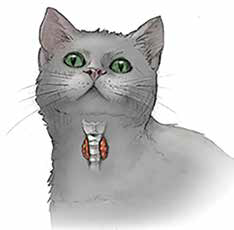Hyperthyroidism occurs when a tumor on one or both of the thyroid glands in your cat’s neck cause excessive production of thyroid hormone. About 98% of these tumors are benign, but all that extra thyroid hormone circulating throughout your cat’s body can wreak havoc on her metabolism.
Common symptoms of hyperthyroidism include weight loss, increased appetite, unkempt coat, increased drinking and urination, hyperactivity and possibly increased aggression, vomiting, and changes in the cat’s voice. You may also be able to feel the enlarged thyroid gland(s) on your cat’s neck under her chin. Left untreated, hyperthyroidism can lead to hypertension, which can damage your cat’s kidneys, retinas, heart, and brain.
Be Proactive
“Veterinarians are diagnosing hyperthyroidism earlier than ever,” says Meredith Miller, DVM, DACVIM, Senior Lecturer in Small Animal Internal Medicine at Cornell University’s College of Veterinary Medicine. With routine screening bloodwork and close attention to subtle symptoms that show up on annual exams, Dr. Miller says, “Diagnosing this disease earlier in the course can prevent some of the more common and challenging complications of hyperthyroidism, such as structural changes to the heart.”
Research on the Horizon
For all we know about hyperthyroidism, we still don’t know what causes it. A study published in the Journal of the Endocrine Society in 2020 is one of the early steps in evaluating whether reproductive hormones may play a role. It was already known that the structure of luteinizing hormone (LH, a reproductive hormone) is similar to thyroid stimulating hormone (TSH), and that they are able to trigger receptors intended for the opposite hormone in research settings. This study looked at the levels of LH in both intact and neutered cats and found that neutered cats have increased LH concentrations. Future studies will be needed to evaluate whether this means anything for hyperthyroidism in cats. “This is challenging to comment on since most cats in the U.S. are neutered, but there is no known correlation between neuter status and hyperthyroidism. In my mind, the challenges of managing an intact male cat outweigh the potential risks of developing a readily treatable (and even curable) disease like hyperthyroidism,” says Dr. Miller.
The onus is on you, however. You’ll need to say yes to annual screening bloodwork. “Annual screening of thyroid hormone levels should be performed in any cat over 8 years old or anytime clinical signs of increased appetite, weight loss, increased thirst, urination, and hyperactivity are detected by owners,” says Dr. Miller. There are several tests and panels that evaluate thyroid hormones, but the most common starting point is a T4 (thyroxine, the thyroid hormone that plays a role in heart and muscle function, brain development, and digestion).
If your cat’s bloodwork comes back normal, that isn’t wasted money. Your veterinarian will keep track of your cat’s values to watch for changes and trends that develop over time. For example, T4 levels tend to drop in older cats. So, a senior cat may have a T4 level at the high end of normal but still be symptomatic for hyperthyroidism. Previous T4 levels may show that the current T4 is a spike upward for your cat. The hyperthyroidism diagnosis can be confirmed with additional thyroid tests.
If your cat has been diagnosed with hyperthyroidism and is being treated with methimazole, she will need regular bloodwork to make sure that her current medication dosage is regulating her thyroid hormone levels adequately. While treating hyperthyroidism medically is often effective, it does not address the underlying cause. As the tumor(s) on the thyroid gland(s) continue to grow, your cat will likely need a higher dose of medication to control symptoms.
In addition to T4 levels, the American Association of Feline Practitioners recommends monitoring blood pressure during all routine veterinary visits for all hyperthyroid cats. This is because 15 to 20% of cats with hyperthyroidism develop high blood pressure, which can damage your cat’s kidneys, brain, retinas, and heart. There are medications that can help to combat hypertension.
Transdermal Medication Options
Right now, the only FDA-approved medication for treating feline hyperthyroidism is Felimazole, coated methimazole tablets. But as many cat owners know, getting pills into a cat twice a day can be challenging! For these cats, transdermal gel formulations can be ordered from a compounding pharmacy. Dr. Miller says, “Despite it not being FDA approved, I do not hesitate to use transdermal methimazole, because we have an objective way to determine if and how well it is working by monitoring T4 concentrations. The compounded formula is only as good as the compounding pharmacy but, overall, we know that the bioavailability is lower in transdermal methimazole (compared to oral) and takes longer to take effect.”
Dr. Miller has some tips for getting the best results from transdermal methimazole. “Owners should always wear gloves or finger cots to avoid absorption of the drug. It is important to alternate ears and remove any crusty material (with a damp cloth or moistened cotton ball) before administration.”
Should we expect an FDA-approved transdermal option for treating hyperthyroidism in the near future? Dr. Miller says there’s potential. A 2020 study published in Schweizer Archiv fur Tierheilkunde looked at the safety and efficacy of a new dermal formulation: amphiphilic dendritic core-multishell-nanocarriers. While the name is somewhat intimidating, the outcome was positive: Thiamazole [methimazole] ointment based on nanocarriers is suitable for the treatment of feline hyperthyroidism. Perhaps this product will ultimately become FDA approved and routinely available.
Tips for Feeding y/d Diet
If you have a hyperthyroid cat and have opted to treat her either solely or in part with the limited-iodine prescription diet Hills y/d, you already know that going off-diet is not allowed. Any treats or foods stolen from other pets can potentially contain enough iodine to increase your cat’s iodine levels, leading to increased thyroid hormone production.
But what you might not have known is that foods aren’t the only source of excess iodine. Well water can include levels of iodine that might be too much for your cat’s restricted iodine diet, and bowls used for other foods or even shared with pets eating other foods can be a source of contamination.
Consider Radioactive Iodine Therapy
While not new, radioactive iodine therapy (RAIT) isn’t utilized as much as it could be for hyperthyroid cats. “I wish owners knew that radioactive iodine therapy is a definitive treatment, i.e., it is treating the underlying cause of hyperthyroidism in cats (thyroid adenoma/adenomatous hyperplasia) vs. managing the result of hyperthyroidism,” says Dr. Miller. “Treating with methimazole or an iodine restricted diet mitigates the hormone production and clinical signs of hyperthyroidism but does not treat the underlying cause. Thus, many cats become resistant to these therapies over time as their untreated thyroid tumors continue to grow. I think this is becoming more of a problem as our senior cats experience greater longevity with the exceptional care their owners can provide to them.”
Early detection of hyperthyroidism with regular screening bloodwork makes RAIT an even better treatment option. “I would encourage owners to talk to their veterinarians about radioiodine treatment soon after diagnosis,” says Dr. Miller. “The investment in RAIT earlier in the disease course can deter complications and long-term challenges (and cost required) in treating hyperthyroidism later in its course. A cat that has been treated with methimazole for five years with a large thyroid tumor is more challenging to safely treat with radioiodine than the cat who was diagnosed in the last year with a smaller thyroid tumor.” The cure rate with a single treatment is between 95 and 98%.
How does it work? An injection of radioactive iodine is given under the skin, where it then travels to the thyroid glands. The tumor cells are destroyed, bringing the cat back to normal thyroid hormone production levels. Because your cat will be temporarily radioactive, she will need to stay at the veterinary facility for between three and seven days so that she doesn’t expose you or your family.
Once back at home, for the first several weeks you will need to take a little extra care when handling and caring for her to minimize radiation exposure, but after that everything can go back to normal. While it sounds like science fiction, this is a very safe and effective treatment option that the Veterinary College at Cornell University has been offering for over 25 years.
What You Can Do
- Watch for symptoms: unexplained weight loss, increased appetite, increased drinking and urination, unkempt coat, lump under chin, behavioral changes, etc.
- Include thyroid levels (usually T4) in routine screening bloodwork for cats 8 years of age and older
- Discuss treatment options with your veterinarian



